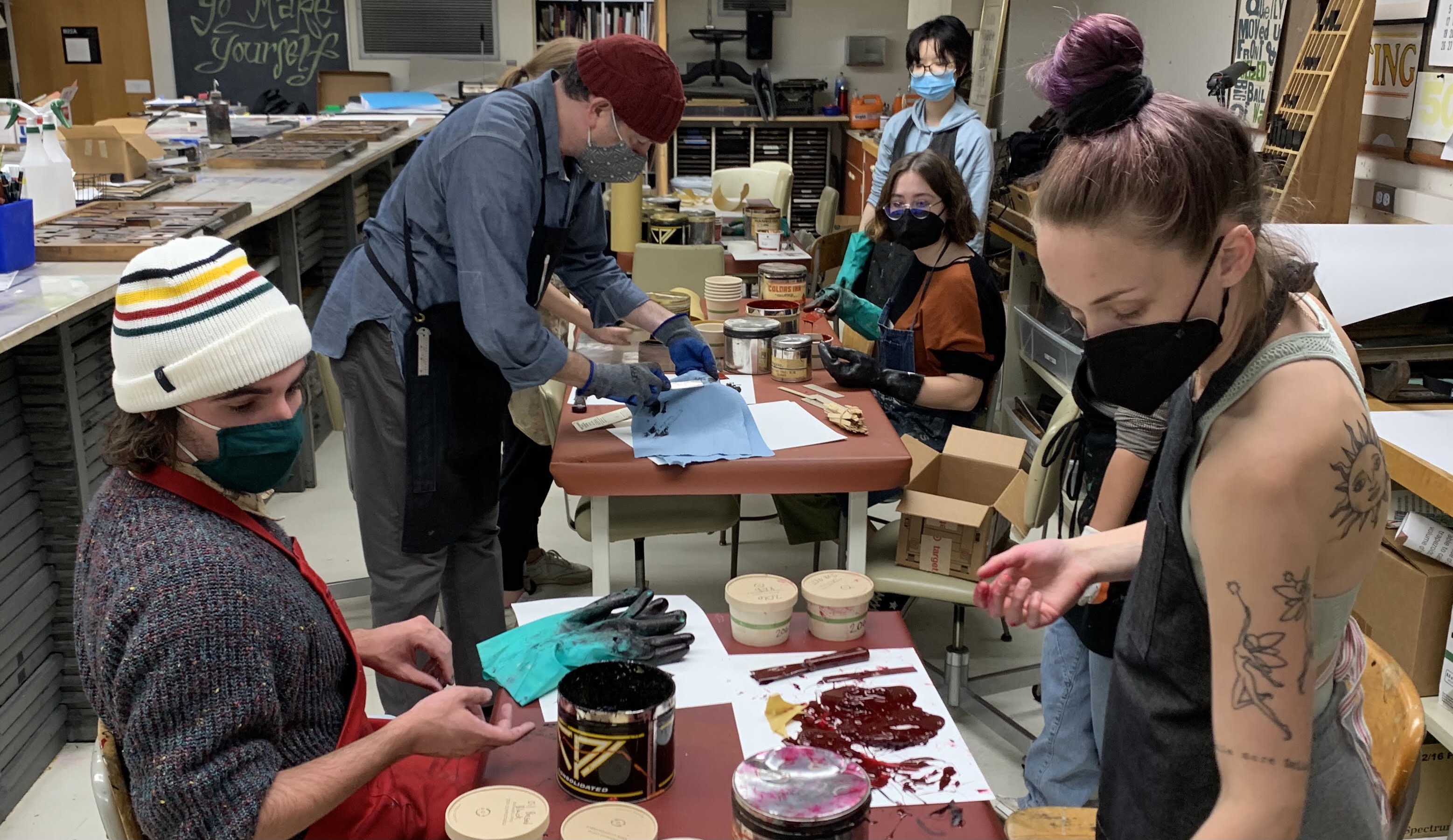Over the past two years, students, faculty, and staff have risen to the ongoing challenges posed by the COVID-19 pandemic by embracing new technology and finding innovative ways to create valuable classroom experiences remotely. Yet, virtual learning and prioritizing safety for students have limited opportunities to work in-person with traditional tools such as the letterpress.

To compensate for students’ limited access to physical production and experimentation during the initial COVID-19 wave, two graphic design instructors, Karl Engebretson and Bill Moran, have created a new Letterpress Apprenticeship Program. “This program opens up a more official time and place for letterpress exposure as well as an opportunity to connect with students from a wider group—beyond who we have directly instructed,” explained Engebretson.
The initial cohort of apprentices is composed of 17 students from across design disciplines and meets monthly. Apprentices experiment with printmaking, take care of the studio, and learn how to care for the machines. “It is our goal to give students fundamental training in operating the machines and how to safely use the space. We want them to feel confident in producing work beyond their computer and expose them to creative (mass) production through the rich tradition of letterpress printing,” said Engebretson.
“I really enjoy any time I get to use graphic design skills outside of a computer,” said Zoe Keck (Graphic Design). “The few times I used the printing studios during class reminded me how much I enjoyed being able to create something without looking at a screen. That’s one reason this program caught my eye. I also wanted to learn a new skill that pertains to design, and letterpress is a pretty fun one to get into.”
Keck wasn’t the only student drawn to the program because of prior experiences with College of Design print studios. “I’m a big fan of letterpress and the studio space we have in McNeal,” said Patrick Schultz (Graphic Design). “I’ve been hanging out and making prints in there for a while, so getting involved in the Letterpress Apprenticeship made a lot of sense for me. Not to mention Bill and Karl are some of the greatest instructors I’ve ever had and their areas of expertise happen to be my areas of interest.”
The interdisciplinary nature of the apprenticeship has enabled students to forge new connections across programs and years. “Working in groups in the studio has been my favorite part,” said Keck. “I didn’t know anybody who was doing the apprenticeship, and I’ve met a lot of people from various years in school that I probably wouldn’t have met otherwise. It’s interesting to get to know everyone’s personal style in a setting where none of us really know what we’re doing, so learning this really special skill together has been great.”
As the program begins its second semester, Engebretson and Moran want to connect the group with more programs and faculty from across the college. The first collaboration occurred in fall of 2021 when apparel design students made workshop aprons for the apprentices to use out of recycled fabrics. “We hope that other programs, courses, and centers can utilize this group to expand their educational goals or mission through collaborative projects,” concluded Engebretson.
Interested in joining the Letterpress Apprenticeship Program? Email Lecturer Karl Engebretson at [email protected].
The concept that science can and should be accessible to all is the grounding principle behind the Science Communication Lab at the University of Minnesota. Founded to provide interdisciplinary internship opportunities, the lab has consistently attracted College of Design undergraduate students interested in creating stories or media that make complex research and scientific topics accessible to the general public.
Whether it’s buying a coffee every morning or relying on take-out for dinner, convenience makes it easy to overlook the long-term consequences of our consumption choices. Last fall, graphic design students in 2399W: Design and its Discontents were challenged to examine their own consumption habits and create a tangible representation of what they discovered.
Students in GDes 3353: Packaging and Display partnered with a student group from the College of Food, Agricultural and Natural Resource Sciences (CFANS) last fall to create a brand identity for a proposed tap house on the St. Paul campus.





